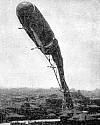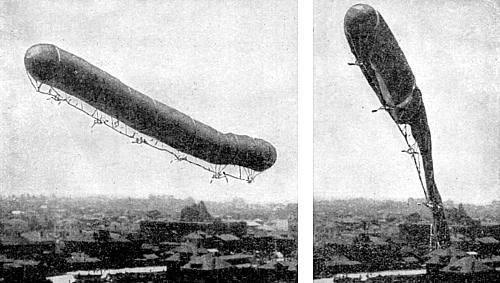
|
Morrell Airship Collapse - 23 May 1908
First major U.S. airship disaster.
|
Huge Dirigible Balloon Collapses
Immense Gas Bag Bursts at Height of 300Ft.—Sixteen Persons Hurled to Earth
from Popular Mechanics (1908)

[p.449] The most ambitious flight of a dirigible balloon ever attempted in the United States, and probably in the entire world, met with disaster at Berkeley, Cal., on May 23, when the Morrell airship, 450 ft. long, collapsed 300 ft. above the earth, hurling its 16 occupants, by far the largest number ever attempting a flight in an airship, to the earth in a maimed and bleeding mass. Nearly all were seriously injured, receiving either broken limbs, internal injuries, or both. J. A. Morrell, the inventor, suffered a broken leg, a dislocated hip and internal injuries. Captain Penfield, well known as an Australian aeronaut, who made the flight against the wishes of Inventor Morrell as a stowaway, was dragged out of the wreck with both legs broken at the ankle.
It was estimated that not less than 15,000 people witnessed the ascension, collapse and fall of the dirigible airship. So many were hurt, so serious were the injuries, and so great the menace to those who stood near the point of ascension, that women became hysterical or fainted in the excitement.
The first trouble was encountered just before the flight upward was taken. Morrell had difficulty in getting his men to hear orders, and the airship wobbled dizzily from its guy ropes and anchors. One end of the bag appeared full and distended, but the other end sagged inward and appeared to be of uncertain quality. Finally the long cigar-shaped stretch of canvas straightened out evenly and appeared to swim into equilibrium. Morrell dropped his hat as a signal to let go and the men below began to loosen the ropes. There was some irregularity noticeable in the doing of this and one end of the ship shot upward considerably in advance of the other. The airship continued to rise—a strange-looking engine of flight with the crew clinging to the canvas keel swinging from the mesh of the gas bag.

Left Hand View Was Taken a Moment After Rupture of Bag: Note Partial Collapse
[p.450] At a height of 300 ft. there was a sharp crackle of the bag, and a lengthwise rent appeared near the center. The forward end crumpled up like paper, and the whole assemblage of balloon, engines and occupants shot, toward the earth. The flight upward and the fall to earth again took no more than 5 minutes.
A horrifying medley of shouts and shrieks from the thousands of people clustered about rent the air as the airship was seen to collapse. For a moment it seemed that the ship and its weight of engines would fall directly into the mass of women and children that crowded every available inch of space, but they marvelously escaped.
The diameter of the gas bag was 36 ft. and when filled with the 485,000 cu. ft. of gas which it contained when the flight commenced, had a lifting capacity of at least 6 tons. Morrell describes the ship as a combination of the aeroplane and the dirigible balloon. Below the huge canvas bag was a keel upon which were mounted five 60-hp. gasoline engines. These engines were placed 60 ft. apart, and each operated a combination propeller and an aeroplane. Each engine had a special engineer. The propelling fans or aeroplanes, as the inventor called them, were made of light wood, the blades covered with oiled silk. Two blades on a side were operated by each engine.
The gas bag was not silk, the material generally used in the manufacture of balloons, but a sort of unbleached cotton canvas, covered with a coat of paint or varnish, and it is generally believed that it was the weakness of this material which caused the collapse.
Three theories were advanced as to the immediate cause of the accident. These were that one of the engines was improperly placed and caused derangement of equilibrium, that a guy rope was not cast off simultaneously with the others and cut through the gas bag, and that the bag was improperly inflated.
Colonel Postnikov, formerly an officer of the Russian army, at present living in Berkeley, predicted the disaster several days before the flight. During the Russian-Japanese war he was in charge of the balloon corps at Vladivostok. His reason for such a prediction was his belief that the material used in the construction of the gas bag was not strong enough to hold the volume of gas forced into it.
Inventor Morrell estimated his loss at $40,000.
 Falling With a Wrecked Airship - second article
on Morrell's Airship Collapse in Popular
Mechanics (Aug 1908).
Falling With a Wrecked Airship - second article
on Morrell's Airship Collapse in Popular
Mechanics (Aug 1908). Old Fabric Caused Airship Wreck
- third month's article
on Morrell's Airship Collapse in Popular
Mechanics (Sep 1908).
Old Fabric Caused Airship Wreck
- third month's article
on Morrell's Airship Collapse in Popular
Mechanics (Sep 1908). 23
May - short
biography, births, deaths
and events on date of Morrell's Airship Collapse.
23
May - short
biography, births, deaths
and events on date of Morrell's Airship Collapse. Booklist
for Airships History
Booklist
for Airships History




